Movements - 29
Ready Posture - CLOSED READY STANCE C |
| 1. |
Step Right Foot into Square Horse Stance,
Left Palm Heel. |
| 2. |
Right Punch. |
| 3. |
Left Punch. |
| 4. |
Step to Right Back Stance to 3 oclock, C-Block.
|
| 5. |
Left Upper Punch. |
| 6. |
Right Inward Hammer. |
| 7. |
Hop up while Right Downward Knifehand Strike. |
| 8. |
Step to Left Forward to 3 oclock, Left Punch.
|
| 9. |
Step to Left Forward to 12 oclock, Left Downward
Block. |
| 10. |
Step to Right Forward Stance, Right Punch.
|
| 11. |
Steep Left Foot to Right, Chamber on Right.
|
| 12. |
Land in Left Back Stance, Right Shuto. |
| 13. |
Step to Left Forward Stance, Left Punch. |
| 14. |
Step to Right Forward Stance, Right Punch.
|
| 15. |
Step to Left Back Stance to 3 oclock, Left
Check. |
| 16. |
Step to Right Forward Stance, Right Spear. |
| 17. |
Step to Left Back Stance to 9 oclock, Left
Check. |
| 18. |
Right Round Kick, Land in Right Back Stance,
Right Check. |
| 19. |
Left Round Kick, Land in Left Back Stance,
Left Check. |
| 20. |
Step to Left Forward Stance to 6 oclock, Left
Downward Block. |
| 21. |
Right Punch, Shifting to Box Stance. |
| 22. |
Step to Right Back Stance, Left Punch. |
| 23. |
Step to Left Back Stance, Right Punch. |
| 24. |
Shift to Left Forward Stance, X-Downward block.
|
| 25. |
Step Right Leg Around, Right Hand Downward
Knife Block. |
| 26. |
Step Left to Right Foot, facing 9 oclock.
|
| 27. |
Scissor Blocks. |
| 28. |
Step to Left Back Stance to 9 oclock, Left
Outward Block. |
| 29. |
Shuffle to Right Back Stance to 3 oclock,
Right Outward Block. |
| END: Bring the right foot back to a ready
posture. |
HWA-RANG is named after the Hwa-Rang youth
group, which originated in the Silla Dynasty in the early 7th
century. The 29 movements refer to the 29th Infantry Division,
where Taekwon-Do developed into maturity.
The Beginning
The Hwarang were leaders of military bands of the Silla Dynasty.
They were chosen from the young sons of the nobility by popular
election. Each Hwarang group consisted hundreds or thousands
of members. The leaders of each Hwarang group, including the
most senior leader, were referred to as Kuk-Son. The Kuk-Son
was very similar to King Arthur's Knights of the Round Table
in England 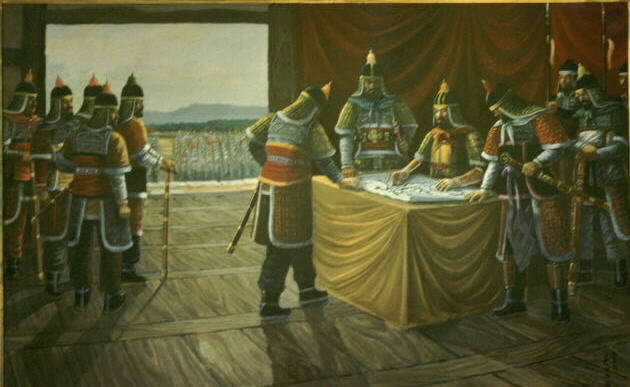 around
1200. From their ranks were chosen government officials, military
leaders, field generals, and even kings who served Silla both
in times of peace and war. Most of the great military leaders
of Silla were products of Hwarang training, and many were Kuk-Son.
around
1200. From their ranks were chosen government officials, military
leaders, field generals, and even kings who served Silla both
in times of peace and war. Most of the great military leaders
of Silla were products of Hwarang training, and many were Kuk-Son.
Silla, established in 57 B.C., was the smallest of the three
kingdoms comprising what is now Korea. The citizens of Silla
were outnumbered and under continual threat of military domination
from the neighboring kingdoms of Paekche and Koguryo for over
700 years.
The Hwarang were established by Chin Hung, the 24th King of
Silla (540 A.D.), who was a devoted Buddhist and loved elegance
and physical beauty. He believed in mythical beings and male
and female fairies (Sin-Sun and Sun-Nyo). These beliefs led
him to hold beauty contests the prettiest maidens in the country,
which he called WonHwa (Original Flowers). He taught them modesty,
loyalty, filial piety, and sincerity so they would become good
wives. In one contest among 300-400 Won-Hwa, two exceptionally
beautiful young women were favored, Nam-Mo and Joon-Jung. Unfortunately,
the two began to struggle for power and influence between themselves.
Finally, in order to win the contest, Joon Jung got Nam-Mo drunk
and killed her by crushing her skull with a rock. When the unfortunate
maiden's body was found in a shallow grave by the river, the
king had Joon-Jung put to death and disbanded the order of the
Won-Hwa.
Several years after this incident the King created a new order,
the Hwarang. "Hwa" meant flower or blossom, and "Rang"
meant youth or gentle men. The word Hwarang soon came to stand
for Flower of Knighthood. These Hwarang were selected from handsome,
virtuous young men of good families. Their selection was carried
out by popular vote among their followers; then they were presented
to the king for nomination as a Hwarang or Kuk-Son. They learned
the five cardinal principles of human relations (kindness, justice,
courtesy, intelligence, and faith), the three scholarships (royal
tutor, instructor, and teacher), and the six ways of service
(holy minister, good minister, loyal minister, wise minister,
virtuous minister, and honest minister). The education of a
Hwarang was supported by the king and generally lasted ten years,
after which the youth usually entered into some form of service
to his country. King Chin Hung sent the Hwarang to places of
scenic beauty for physical and mental culture as true knights
of the nation. For hundreds of years the Hwarang were taught
by Kuk-Son in social etiquette, music and songs, and patriotic
behavior.
Buddhist philosophy
The Hwarang were taught the martial arts and Buddhist faith
and indoctrinated in the ways of cultured and chivalrous warriors.
They climbed rugged mountains and swam rapid rivers in all months
of the year, conditioning their minds and bodies for endurance
and discipline. Much of their training time was spent in the
mountains, at the seashore, and on wilderness excursions; training,
meditating, and composing songs and poetry. They were taught
dance, literature, arts, and sciences, and the arts of warfare,
charioteering, archery, and hand-to-hand combat. The hand-to-hand
combat was based on the Um-Yang principles of Buddhist philosophy
and included a blending of hard and soft, linear and circular
techniques. The art of foot fighting was known as Soo-Bak and
was practiced by common people throughout the three kingdoms.
However, the Hwarang transformed and intensified this art and
added hand techniques, renaming it Tae-Kyon. The Hwarang punches
could penetrate the wooden chest armor of an enemy and kill
him; foot techniques were said to be executed at such speed
that opponents frequently thought that the feet of Hwarang warriors
were swords. In later centuries the king of Koryo made Tae-Kyon
training mandatory for all soldiers, and annual Tae-Kyon contests
were held among all members of the Silla population on May 5th
of the Lunar Calendar.
The rank of Hwarang usually meant a man had achieved the position
of a teacher of the martial arts and commanded 500-5,000 students
called Hwarang-Do. A Kuk-Son was the master and held the rank
of general in the army. Hwarang fighting spirit was ferocious
and was recorded in many literary works including the Sam-Guk-Sagi,
written by Kim Pu-Sik in 1145, and the Hwarang-Segi. The latter
was said to have contained the records of lives and deeds of
over 200 individual l Hwa- sadly, it was lost during the Japanese
occupation in the 20th century.) The zeal of the Hwarang helped
Silla become the world's first ''Buddha Land" and led to;
the unification of the three kingdoms of Korea. Buddhist principles
were so ingrained in the code of the Hwarang that a larger number
of monks participated in the Hwarang-Do), and during times of
war they would robes and take up or ms to die for Silla.
The Hwarang code
The Hwarang code was established in the 3Oth year of King Chin-Hung's
rule. Two noted Hwarang warriors, Kwi-San and Chu-Hang, sought
out the famous warrior and Buddhist monk Wong-Gwang Popsa in
Kusil temple on Mount Unmun and asked that he give them lifetime
commandments that those men could follow who could not embrace
the secluded life of a Buddhist monk. The commandments, based
on Confucian and Buddhist principles, were divided into five
rules (loyalty to the king and country, obedience to one's parents,
sincerity, trust and brotherhood among friends, never retreat
in battle, and selectivity and justice in the killing of living
things), and nine virtues (humanity, justice, courtesy, wisdom,
trust, goodness, virtue, loyalty, and courage). These principles
were not taken lightly, as in the case of Kwi-San and Chu-Hang,
who rescued their own commander, General Muun, when 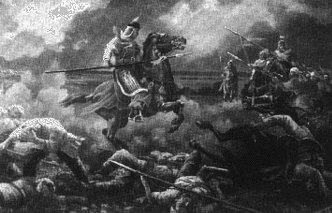 he
was ambushed and fell from his horse during a battle in 603
A.D. Attacking the enemy, these two Hwarang were heard to cry
out to their followers, "Now is the time to follow the
commandment to not retreat in battle!" After giving one
of their horses to the general, they killed a great number of
the pursuing enemy and finally, "bleeding from a thousand
wounds," they both died.
he
was ambushed and fell from his horse during a battle in 603
A.D. Attacking the enemy, these two Hwarang were heard to cry
out to their followers, "Now is the time to follow the
commandment to not retreat in battle!" After giving one
of their horses to the general, they killed a great number of
the pursuing enemy and finally, "bleeding from a thousand
wounds," they both died.
The code of the Hwarang is similar to the more commonly known
code of the Japanese samurai, Bushido. The Bushido code was
established in feudal Japan during the 12th to the 17th centuries
to serve as a social guide rule of life, and set of ideals for
the samurai or military class. The code of the Hwarang-Do played
a similar role in the Korean kingdom of Silla approximately
1,000 years earlier. Being established during the 6th to the
10th centuries, Hwarang-Do was considered more ancient and refined
than Bushido. The Silla Dynasty lasted 1,000 years, and the
Code of the Hwarang, known as Sesok-Ogye, endured throughout
the Silla and Koryo dynasties. Its influence led to a unified
national spirit and ultimately the unification of the three
kingdoms of Korea around 668 A.D. The practice of Bushido appears
to have perpetuated a feudal system in Japan for over 700 years
with continual provincial wars, whereas Silla and Koryo thrived
under the influence of the Hwarang. These Korean dynasties,
based on Hwarang ethics, remained internally peaceful and prosperous
for over 1,500 years while defending themselves against a multitude
of foreign invasions. This can be compared to the Roman Empire,
which thrived for only 1,000 years. Oyama Masutatsu, a well-known
authority on Karate in Japan, has even suggested that the Hwarang
were the forerunners of the Japanese samurai.
The first recorded Hwarang hero
Sul Won-Nang was elected as the first Kuk-Son or head of the
Hwarang order. But the first recorded Hwarang hero was Sa Da-Ham.
At the young age of 15 he raised his own 1,000-man army in support
of Silla in its war against the neighboring kingdom of Kara.
He requested and was granted the honor of leading this force
in support of the Silla army attacking the main fort of the
Kara in 562 A.D. As the first to breach the walls of the enemy
fort, he was highly praised and rewarded by King Chin Hung for
his bravery. He was offered 300 slaves and a large tract of
land as a reward, but released the slaves and refused the land,
stating that he did not wish to receive 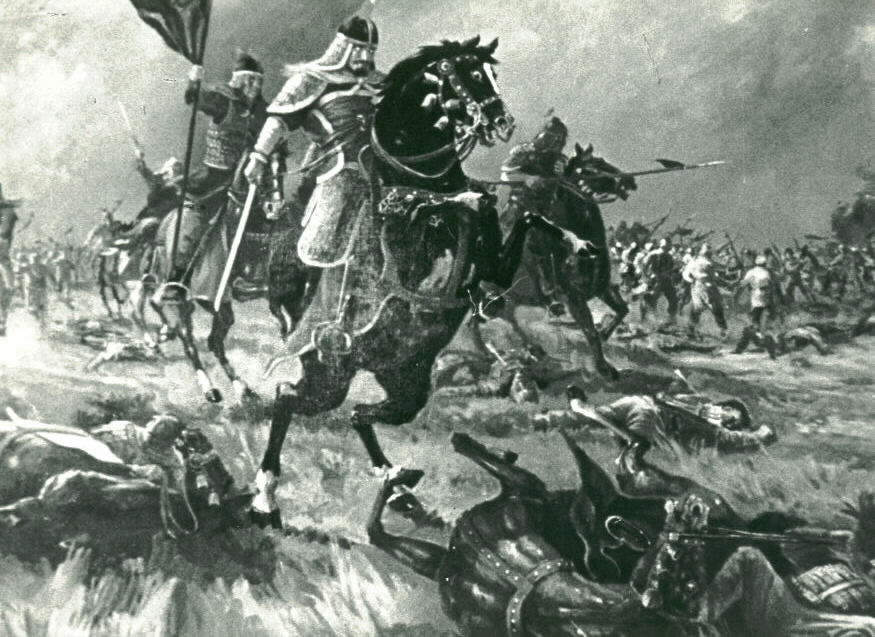 personal
rewards for his deeds. He did agree to accept a small amount
of fertile soil as a matter of courtesy to the King. However,
when his best friend was killed in battle, Sa Da-Ham was inconsolable.
As a youth Sa Da-Ham and his friend had made pact-of-death should
either of them ever die in battle. True to his promise, Sa Da-Ham
starved himself to death demonstrating his loyalty and adherence
to the code of the Hwarang.
personal
rewards for his deeds. He did agree to accept a small amount
of fertile soil as a matter of courtesy to the King. However,
when his best friend was killed in battle, Sa Da-Ham was inconsolable.
As a youth Sa Da-Ham and his friend had made pact-of-death should
either of them ever die in battle. True to his promise, Sa Da-Ham
starved himself to death demonstrating his loyalty and adherence
to the code of the Hwarang.
The driving force in the unification of the Korean
Another legendary Korean was General Kim Yoo-Sin who became
a Hwarang at the age of 15 and was an accomplished swordsman
and a Kuk-Son by the time he was 18 years old. By the age of
34 he had been given the command of the Silla armed forces.
He is regarded as the driving force in the unification of the
Korean peninsula and the most famous of all the generals in
the unification wars. Kim Yoo-Sin was active on all fronts in
the wars, and at several times simultaneously conducted battles
against both Paekche and Koguryo. He defeated the great Paeckche
general Gae-Baek in the battle in which Gae-Back was killed.
Once, while Silla was allied with China against Paekche, a heated
argument began between Kim Yoo-Sin's commander and a Chinese
general. As the argument escalated into a potentially bloody
confrontation, the sword of Kim Yoo-Sin was said to have leaped
from its scabbard into his hand. Because the sword of a warrior
was believed to be his soul, this occurrence so frightened the
Chinese general blat he immediately apologized to the Silla
officers. Incidences such as this kept the Chinese in awe of
the Hwarang. In later years when asked by the Chinese emperor
to attack Silla, the Chinese generals claimed that although
Silla was small, it could not be defeated. Kim Yoo-Sin lived
to the age of 79 and is considered one of Korea's most famous
generals. He had five sons, who along with his wife contributed
great deeds to the historical records of the Hwarang.
 Another
dedicated Hwarang, Kwan Chang, became a Hwarang commander at
the age of 16 and was the son of Kim Yoo-Sin's Assistant General
Kim Pumil. In 655 A.D., he fought in the battle of Hwangsan
against Paekche under General Kim Yoo-Sin. During this battle
he dashed headlong into the enemy camp and killed many Paekche
soldiers, but was finally captured. Ibis high ranking battle
crest indicated that he was the son of a general so he was taken
before the Paekche general, Gae-Baek. Surprised by Kwan Chang's
youthfulness when his helmet was removed, and thinking of his
own young son, Gae-Baek decided that instead of executing him
as was the custom with captured officers, he would return the
young Hwarang to the Silla lines. GaeBaek remarked, "Alas,
how can we match the army of Silla! Even a young boy like this
has such courage, not to speak of Silla's men." Kwan Chang
went before his father and asked permission to be sent back
into battle at the head of his men. After a day-long battle
Kwan Chang was again captured. After he had been disarmed, he
broke free of his two guards, killing them with his hands and
feet, and then attacked the Paekche general's second in command.
With a flying reverse turning kick to the head of the commander,
who sat eight feet high atop his horse, Kwan Chang killed him.
After finally being subdued once more, he was again taken before
the Packche general. This time Gae-Baek said "I gave you
your life once because of your youth, but now you return to
take the life of my best field commander." He then had
Kwan Chang executed and his body returned to the Silla lines.
General Kim Pumil was proud that his son had died so bravely
in the service of his king. He said to his men, "it seems
as if my son's honor is alive. I am fortunate that he died for
the King." He then rallied his army and went on to defeat
the Paekche forces.
Another
dedicated Hwarang, Kwan Chang, became a Hwarang commander at
the age of 16 and was the son of Kim Yoo-Sin's Assistant General
Kim Pumil. In 655 A.D., he fought in the battle of Hwangsan
against Paekche under General Kim Yoo-Sin. During this battle
he dashed headlong into the enemy camp and killed many Paekche
soldiers, but was finally captured. Ibis high ranking battle
crest indicated that he was the son of a general so he was taken
before the Paekche general, Gae-Baek. Surprised by Kwan Chang's
youthfulness when his helmet was removed, and thinking of his
own young son, Gae-Baek decided that instead of executing him
as was the custom with captured officers, he would return the
young Hwarang to the Silla lines. GaeBaek remarked, "Alas,
how can we match the army of Silla! Even a young boy like this
has such courage, not to speak of Silla's men." Kwan Chang
went before his father and asked permission to be sent back
into battle at the head of his men. After a day-long battle
Kwan Chang was again captured. After he had been disarmed, he
broke free of his two guards, killing them with his hands and
feet, and then attacked the Paekche general's second in command.
With a flying reverse turning kick to the head of the commander,
who sat eight feet high atop his horse, Kwan Chang killed him.
After finally being subdued once more, he was again taken before
the Packche general. This time Gae-Baek said "I gave you
your life once because of your youth, but now you return to
take the life of my best field commander." He then had
Kwan Chang executed and his body returned to the Silla lines.
General Kim Pumil was proud that his son had died so bravely
in the service of his king. He said to his men, "it seems
as if my son's honor is alive. I am fortunate that he died for
the King." He then rallied his army and went on to defeat
the Paekche forces.
The spirit of the Hwarang was present in all of the kingdoms
of Korea during this time, and although not as evident as in
Silla, it was demonstrated by such great Korean historical figures
as Yon-Gye, Ul-Ji Moon-Duk, and Moon- Moo This spirit was kept
alive throughout history by many individuals. Hwarang and the
martial arts fell out of favor during the Yi Dynasty (1392-1910)
and adherence to the 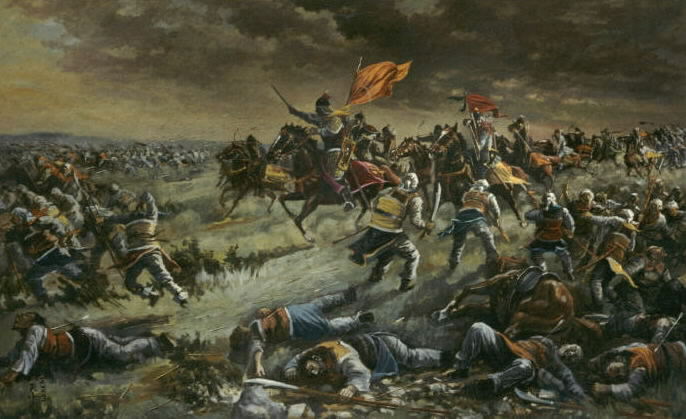 Hwarang
code declined. Several Koreans did keep the code, however, notably
Admiral Yi Sun-Sin who was instrumental in defeating the Japanese
invasions of Korea in 1592 and 1597. The spirit of the Hwarang
and their code was present in Buddhist temples by monks. For
example, in the 16th century two monks, Su San and who followed
the Hwarang code, rallied a Buddhist army that was instrumental
in driving the Japanese invasion forces from Korea
Hwarang
code declined. Several Koreans did keep the code, however, notably
Admiral Yi Sun-Sin who was instrumental in defeating the Japanese
invasions of Korea in 1592 and 1597. The spirit of the Hwarang
and their code was present in Buddhist temples by monks. For
example, in the 16th century two monks, Su San and who followed
the Hwarang code, rallied a Buddhist army that was instrumental
in driving the Japanese invasion forces from Korea
Stories of the Hwarang and their individual feats illustrate
the code of the Hwarang, the type of ethics and morality essential
to the evolution of the martial arts and the success Silla as
a nation. This code has profoundly affected the Korean people
and their culture throughout history. The lives and deeds of
the Hwarang illustrate a level of courage, honor, wisdom, culture,
compassion, and impeccable conduct that few men in history have
demonstrated. The dedication and self-sacrifice of the Hwarang
was clearly based on principles much stronger than ego and self
interest. This basis was the Sesok-Ogye, the code of the Hwarang.
Print
Pattern and History - 8/15/02

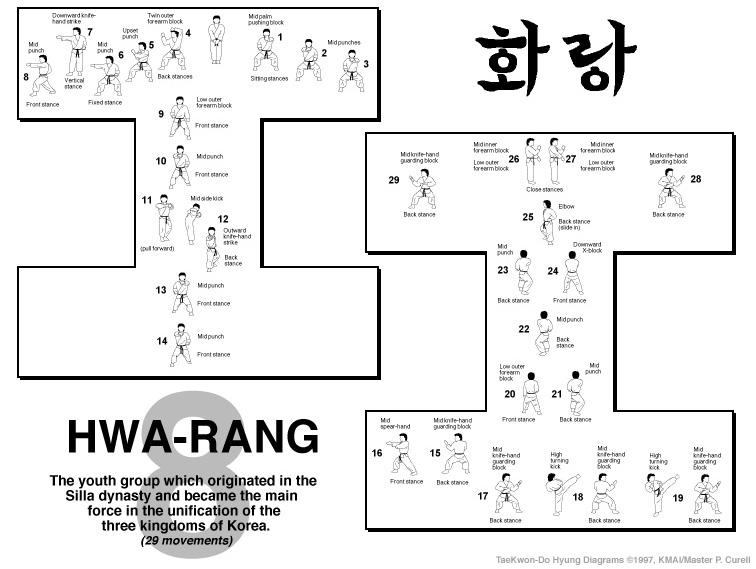
 around
1200. From their ranks were chosen government officials, military
leaders, field generals, and even kings who served Silla both
in times of peace and war. Most of the great military leaders
of Silla were products of Hwarang training, and many were Kuk-Son.
around
1200. From their ranks were chosen government officials, military
leaders, field generals, and even kings who served Silla both
in times of peace and war. Most of the great military leaders
of Silla were products of Hwarang training, and many were Kuk-Son.
 he
was ambushed and fell from his horse during a battle in 603
A.D. Attacking the enemy, these two Hwarang were heard to cry
out to their followers, "Now is the time to follow the
commandment to not retreat in battle!" After giving one
of their horses to the general, they killed a great number of
the pursuing enemy and finally, "bleeding from a thousand
wounds," they both died.
he
was ambushed and fell from his horse during a battle in 603
A.D. Attacking the enemy, these two Hwarang were heard to cry
out to their followers, "Now is the time to follow the
commandment to not retreat in battle!" After giving one
of their horses to the general, they killed a great number of
the pursuing enemy and finally, "bleeding from a thousand
wounds," they both died. personal
rewards for his deeds. He did agree to accept a small amount
of fertile soil as a matter of courtesy to the King. However,
when his best friend was killed in battle, Sa Da-Ham was inconsolable.
As a youth Sa Da-Ham and his friend had made pact-of-death should
either of them ever die in battle. True to his promise, Sa Da-Ham
starved himself to death demonstrating his loyalty and adherence
to the code of the Hwarang.
personal
rewards for his deeds. He did agree to accept a small amount
of fertile soil as a matter of courtesy to the King. However,
when his best friend was killed in battle, Sa Da-Ham was inconsolable.
As a youth Sa Da-Ham and his friend had made pact-of-death should
either of them ever die in battle. True to his promise, Sa Da-Ham
starved himself to death demonstrating his loyalty and adherence
to the code of the Hwarang. Another
dedicated Hwarang, Kwan Chang, became a Hwarang commander at
the age of 16 and was the son of Kim Yoo-Sin's Assistant General
Kim Pumil. In 655 A.D., he fought in the battle of Hwangsan
against Paekche under General Kim Yoo-Sin. During this battle
he dashed headlong into the enemy camp and killed many Paekche
soldiers, but was finally captured. Ibis high ranking battle
crest indicated that he was the son of a general so he was taken
before the Paekche general, Gae-Baek. Surprised by Kwan Chang's
youthfulness when his helmet was removed, and thinking of his
own young son, Gae-Baek decided that instead of executing him
as was the custom with captured officers, he would return the
young Hwarang to the Silla lines. GaeBaek remarked, "Alas,
how can we match the army of Silla! Even a young boy like this
has such courage, not to speak of Silla's men." Kwan Chang
went before his father and asked permission to be sent back
into battle at the head of his men. After a day-long battle
Kwan Chang was again captured. After he had been disarmed, he
broke free of his two guards, killing them with his hands and
feet, and then attacked the Paekche general's second in command.
With a flying reverse turning kick to the head of the commander,
who sat eight feet high atop his horse, Kwan Chang killed him.
After finally being subdued once more, he was again taken before
the Packche general. This time Gae-Baek said "I gave you
your life once because of your youth, but now you return to
take the life of my best field commander." He then had
Kwan Chang executed and his body returned to the Silla lines.
General Kim Pumil was proud that his son had died so bravely
in the service of his king. He said to his men, "it seems
as if my son's honor is alive. I am fortunate that he died for
the King." He then rallied his army and went on to defeat
the Paekche forces.
Another
dedicated Hwarang, Kwan Chang, became a Hwarang commander at
the age of 16 and was the son of Kim Yoo-Sin's Assistant General
Kim Pumil. In 655 A.D., he fought in the battle of Hwangsan
against Paekche under General Kim Yoo-Sin. During this battle
he dashed headlong into the enemy camp and killed many Paekche
soldiers, but was finally captured. Ibis high ranking battle
crest indicated that he was the son of a general so he was taken
before the Paekche general, Gae-Baek. Surprised by Kwan Chang's
youthfulness when his helmet was removed, and thinking of his
own young son, Gae-Baek decided that instead of executing him
as was the custom with captured officers, he would return the
young Hwarang to the Silla lines. GaeBaek remarked, "Alas,
how can we match the army of Silla! Even a young boy like this
has such courage, not to speak of Silla's men." Kwan Chang
went before his father and asked permission to be sent back
into battle at the head of his men. After a day-long battle
Kwan Chang was again captured. After he had been disarmed, he
broke free of his two guards, killing them with his hands and
feet, and then attacked the Paekche general's second in command.
With a flying reverse turning kick to the head of the commander,
who sat eight feet high atop his horse, Kwan Chang killed him.
After finally being subdued once more, he was again taken before
the Packche general. This time Gae-Baek said "I gave you
your life once because of your youth, but now you return to
take the life of my best field commander." He then had
Kwan Chang executed and his body returned to the Silla lines.
General Kim Pumil was proud that his son had died so bravely
in the service of his king. He said to his men, "it seems
as if my son's honor is alive. I am fortunate that he died for
the King." He then rallied his army and went on to defeat
the Paekche forces. Hwarang
code declined. Several Koreans did keep the code, however, notably
Admiral Yi Sun-Sin who was instrumental in defeating the Japanese
invasions of Korea in 1592 and 1597. The spirit of the Hwarang
and their code was present in Buddhist temples by monks. For
example, in the 16th century two monks, Su San and who followed
the Hwarang code, rallied a Buddhist army that was instrumental
in driving the Japanese invasion forces from Korea
Hwarang
code declined. Several Koreans did keep the code, however, notably
Admiral Yi Sun-Sin who was instrumental in defeating the Japanese
invasions of Korea in 1592 and 1597. The spirit of the Hwarang
and their code was present in Buddhist temples by monks. For
example, in the 16th century two monks, Su San and who followed
the Hwarang code, rallied a Buddhist army that was instrumental
in driving the Japanese invasion forces from Korea